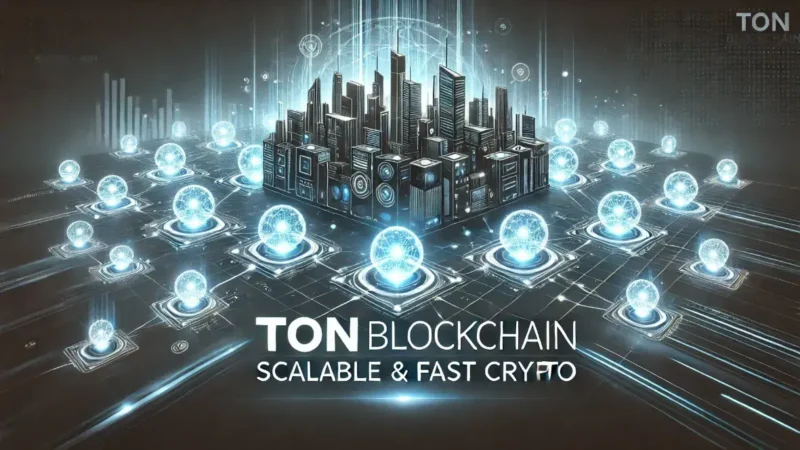Understanding the Polkadot Network: A Comprehensive Guide

Introduction to Polkadot
The Polkadot network, developed by the Web3 Foundation and spearheaded by Ethereum co-founder Gavin Wood, represents a paradigm shift in the realm of blockchain technology. Its primary purpose is to facilitate a multi-chain framework that allows different blockchains to interact and operate cohesively. This unique architecture addresses one of the major limitations inherent in earlier blockchain designs, which often operate in silos. By enabling a robust ecosystem, the Polkadot network seeks to enhance scalability, interoperability, and security across various decentralized applications.
At the heart of Polkadot’s mission is the belief that the blockchain ecosystem needs to evolve from isolated networks into a truly connected environment. This vision is realized through its innovative relay chain, which acts as the central hub, allowing various blockchains—often referred to as “parachains”—to share information and resources. This interconnectedness is crucial for fostering efficient transactions and collaborations among diverse blockchain projects. Through such an architecture, Polkadot aims to eliminate the friction that often comes with cross-chain transactions, thereby enhancing the overall user experience within the digital landscape.
Furthermore, the Polkadot network embodies a governance model that empowers its community. Its unique approach allows token holders to actively participate in decision-making processes, influencing the network’s future developments and upgrades. This decentralized governance structure not only cultivates a sense of ownership among participants but also ensures that the network evolves in a manner that reflects the community’s needs and priorities. By promoting inclusivity, the Polkadot network stands as a vital player in the blockchain ecosystem, aimed at forging a more interconnected and resilient digital future.
The Vision Behind Polkadot
The Polkadot Network was conceived with a clear and ambitious vision: to create a scalable, interoperable, and secure multi-chain architecture that revolutionizes the blockchain ecosystem. The founders aimed to address critical limitations present in existing blockchain networks, such as isolation, scalability issues, and security vulnerabilities. By introducing a framework that facilitates seamless communication between diverse blockchains, Polkadot endeavors to promote the growth of a decentralized web where information and value can be exchanged freely and efficiently.
At the core of this vision is the idea of interoperability. Traditional blockchains often operate in silos, unable to share data or assets with one another. The Polkadot Network addresses this challenge through its unique architecture, which comprises a central relay chain connected to multiple parachains. This design enables various blockchains to communicate without friction, allowing for collaborative ecosystems that harness the strengths of each individual chain. Consequently, developers can create specialized blockchains optimized for specific tasks, while still benefiting from the security and shared resources provided by the relay chain.
Scalability is another critical aspect of Polkadot’s vision. By utilizing a sharded model, where numerous parachains can process transactions independently, the network can achieve a higher throughput than single-chain systems. This innovation can accommodate the growing demands of decentralized applications and facilitate quicker transaction validations, thus enhancing user experience. Furthermore, the Polkadot Network prioritizes security by design, as the shared security model allows all connected chains to benefit from the robust protections afforded by the relay chain.
Ultimately, the vision behind the Polkadot Network seeks to pave the way for a more connected and user-centric blockchain landscape, fostering innovation and inclusivity within the decentralized digital ecosystem.
Key Features of Polkadot
The Polkadot network stands out due to its innovative architecture, which separates the networking and consensus components from the execution layer. This unique design grants various parachains—from multiple blockchain projects—the ability to connect and operate within a shared ecosystem. Essentially, parachains are individual blockchains that can be customized for specific use cases while benefitting from the security and scalability of the main Polkadot relay chain. This separation of functions ultimately enhances flexibility within the network.
Another significant feature of Polkadot is its relay chain, which serves as the core backbone of the network. The relay chain is responsible for the overall security and cross-chain communication between different parachains. By maintaining a robust and secure relay chain, Polkadot allows various blockchains to share information and transact with one another seamlessly. This capability is paramount to promoting interoperability, enabling diverse blockchain ecosystems to collaborate without sacrificing their independence.
Moreover, governance within the Polkadot network is structured to involve its community actively. Token holders can participate in determining the network’s future through proposals and voting mechanisms. This decentralized approach ensures that all stakeholders have a voice in key decisions affecting the network, contributing to its longevity and sustainability. As a result, users can be more confident in the continuous development and enhancement of the Polkadot network, as it evolves alongside the needs of its participants.
In essence, the combination of parachains, a central relay chain, and an inclusive governance model showcases the fundamental advantages of the Polkadot network, making it a pioneering project in the realm of decentralized and interoperable blockchain technologies.
How Polkadot Works
The Polkadot network operates on a unique architecture that facilitates interoperability among various blockchains, known as parachains. At the core of this system lies the relay chain, which serves as the central hub, ensuring security and communication across all connected parachains. This innovative structure allows for a multi-chain ecosystem, fostering seamless interactions and transactions between distinct blockchains.
One key aspect of the Polkadot network is its consensus mechanism, which combines both the Nominated Proof-of-Stake (NPoS) and a decentralized governance model. Validators in the Polkadot ecosystem are selected based on the amount of DOT tokens staked by nominators, ensuring that those with a vested interest in the network maintain its integrity. The relay chain employs the GRANDPA (GHOST-based Recursive ANcestor Deriving Prefix Agreement) protocol for achieving finality, while the Bonding and Staking processes secure and validate transactions across parachains.
The governance model in the Polkadot network is designed to be democratic and inclusive, enabling DOT token holders to propose and vote on changes to the network. This decentralized approach empowers stakeholders, allowing them to influence upgrades and new features, reflecting the dynamic nature of blockchain technology. Such a governance structure not only maintains the stability of the network but also encourages community participation.
Furthermore, the interaction between parachains and the relay chain is facilitated through a messaging protocol known as XCMP (Cross-Chain Message Passing). This mechanism allows parachains to communicate with each other and the relay chain, enabling the transfer of assets and data across different blockchains seamlessly. The combination of an adaptable governance model, a robust consensus mechanism, and a sophisticated messaging protocol positions the Polkadot network as a promising solution for the challenges of interoperability faced by today’s blockchain systems.
Advantages of Using Polkadot
The Polkadot Network presents numerous advantages that make it a compelling choice for developers, businesses, and end-users alike. One of the standout features of this multi-chain framework is its enhanced scalability. By enabling various blockchains to operate in parallel—known as parachains—Polkadot allows for an increase in transaction throughput significantly. This architecture efficiently alleviates congestion issues often seen in traditional single-chain networks, providing a more streamlined experience for users and developers. As more applications and services are established on Polkadot, the scalability offered by its design remains a crucial factor for growth.
Another significant advantage of the Polkadot Network is its unparalleled interoperability. Unlike isolated blockchains, Polkadot facilitates seamless communication between different chains. This interconnectivity allows disparate networks to share information and value without the need for intermediaries, effectively broadening the scope of applications that can be developed. Developers gain the ability to create solutions that tap into various networks, thereby enhancing functionality and user experience. As businesses and services increasingly require collaboration across different ecosystems, this feature positions Polkadot favorably in the blockchain landscape.
Moreover, the flexible deployment of custom blockchains is yet another advantage that highlights Polkadot’s unique proposition. Developers can tailor their blockchains to suit specific needs while still benefiting from the security and infrastructure of the Polkadot Network. This flexibility encourages innovation and experimentation, as teams can create specialized solutions without having to start from scratch. Consequently, this fosters an environment ripe for rapid development and iteration, empowering businesses to adapt quickly to changing market demands. Collectively, these advantages showcase how the Polkadot Network is carving out a distinctive role in the evolving blockchain sector.
Challenges Facing Polkadot
The Polkadot network signifies a groundbreaking evolution in the blockchain ecosystem, offering unique features such as interoperability, shared security, and a flexible governance model. However, despite its promising attributes, it is not without its challenges. One of the primary hurdles is the complexity often encountered by new developers. Unlike more traditional blockchain systems, Polkadot employs a unique and intricate architecture that can be daunting for developers unfamiliar with its concepts. This steep learning curve may deter talented programmers from contributing to projects within the ecosystem initially, potentially slowing down its adoption and innovation.
Additionally, Polkadot faces fierce competition from other blockchain networks that are rapidly gaining traction and popularity. Ecosystems like Ethereum, Binance Smart Chain, and Solana provide developers with robust platforms that are well-established and widely adopted. Some of these alternatives have extensive documentation and communities, which might make them more attractive options for developers looking to launch new projects. The success of Polkadot will heavily depend on its ability to distinguish itself within this crowded market and effectively communicate the advantages it brings to the table.
Scalability is another concern that looms over the Polkadot network. While the shared security model and the concept of parachains are designed to enhance scalability, actual implementation requires meticulous technical planning to ensure efficiency without compromising security. The architecture, which enables multiple blockchains to operate in parallel, also brings forth challenges in managing network traffic and ensuring consistent performance across diverse chains. The balance between scale, speed, and security is a delicate one, and it remains imperative for the Polkadot development team to address these issues to sustain growth and user confidence effectively.
Use Cases of Polkadot
The Polkadot network has established itself as a groundbreaking platform that facilitates interoperability between different blockchains. Its unique architecture allows diverse blockchains to connect and communicate. As such, several real-world applications harness the capabilities of the Polkadot ecosystem across various industries, exemplifying its versatility and potential.
In the finance sector, Polkadot has emerged as a foundation for developing decentralized finance (DeFi) applications. Through its robust cross-chain functionalities, financial platforms can seamlessly interact with multiple blockchains, enabling more efficient transactions, liquidity sharing, and credit scoring. Projects like Acala and Moonbeam leverage the Polkadot network to create decentralized applications that cater to various financial needs, from lending and borrowing to decentralized exchanges, thereby promoting financial inclusion.
Supply chain management is another industry where the Polkadot network finds practical application. By utilizing its capabilities, organizations can build transparent and efficient systems that provide real-time tracking of products. This not only enhances accountability but also allows all stakeholders to access updated information regarding shipments and product origins. The ability to create a unified platform for various entities ensures that data is reliably shared, which is critical in addressing issues like fraud and inefficiencies in supply chains.
Moreover, the development of decentralized applications (dApps) on the Polkadot network opens avenues for innovation in sectors such as gaming, social networking, and data privacy. Projects hosted on Polkadot can benefit from shared security and scalability while utilizing the diverse functionalities available within the ecosystem. This allows developers to create more robust applications capable of handling user demands without compromising on performance.
In conclusion, the Polkadot network’s distinctive features enable a wide array of applications across different industries. By fostering interoperability and encouraging decentralized solutions, it paves the way for innovations that can significantly enhance efficiency and transparency in various domains.
The Future of Polkadot
The Polkadot network stands at a pivotal moment in the evolution of blockchain technology, with a vibrant roadmap that emphasizes scalability, interoperability, and governance. As we look ahead, several key developments are anticipated to shape its trajectory. One of the most significant advancements is the continued enhancement of cross-chain compatibility. The ability of diverse blockchains to communicate seamlessly with one another is a defining feature of Polkadot. This will facilitate a more interconnected ecosystem, allowing assets and data to flow freely across platforms, significantly improving user experience and utilization.
Another area of growth lies in the expansion of parachains. As more developers recognize the advantages of building on the Polkadot network, we may witness a surge in innovative projects leveraging its capabilities. This could lead to increased user adoption and a more diversified array of applications, attracting a broader audience to the network. The success of parachains could also reinforce Polkadot’s position as a leader in the blockchain space, potentially influencing how other platforms approach interoperability and scalability.
Moreover, the Polkadot governance model could serve as a blueprint for decentralized organizations worldwide. With its emphasis on community involvement in decision-making processes, Polkadot seeks to empower users and foster a more democratic approach to governance. The implications of this model could extend beyond Polkadot, impacting the governance structures of various blockchain projects and leading to a shift towards more inclusive frameworks in the digital economy.
In light of these factors, the Polkadot network not only has the potential for significant technological advancements but also the capacity to drive broader trends within the blockchain ecosystem. The next few years look promising, with the network poised to make substantial contributions to the landscape of blockchain technology.
Stay informed, read the latest crypto news in real time!
Conclusion
In this comprehensive guide, we have explored the multifaceted aspects of the Polkadot Network, emphasizing its unique structure, interoperability solutions, and scalability features that distinguish it in the rapidly evolving blockchain landscape. Polkadot operates through a multi-chain framework that facilitates seamless communication between diverse blockchains, thereby enhancing interoperability. This characteristic not only promotes collaboration among different networks but also enables developers to create specialized and efficient parachains that cater to specific use cases.
Furthermore, the governance model employed by the Polkadot Network is notable for its emphasis on community involvement and adaptability. Stakeholders are empowered to participate in decision-making processes, ensuring that the evolution of the network aligns with the interests of its users. This democratic approach fosters transparency and sustainability, which are essential for the long-term success of any blockchain ecosystem.
Moreover, the capabilities of Polkadot in terms of scalability should not be overlooked. By incorporating a sharding mechanism, the network can process multiple transactions concurrently, significantly increasing throughput and reducing congestion. This positions the Polkadot Network as a viable solution for projects that require high transaction capabilities without sacrificing security.
As we conclude, it is important to recognize the Polkadot Network’s potential to shape the future of blockchain technology. Its innovative features and robust infrastructure position it as a key player in fostering a more connected and efficient blockchain environment. We encourage readers to engage further with this network, exploring its possibilities and keeping abreast of developments. As Polkadot continues to evolve, its implications for the broader blockchain ecosystem will undoubtedly be profound.






